East Meets West: Clash of Civilizations
Knowing the details bit by bit of something that is of great importance to you is more than overwhelming.
For quite a while now, I have been enjoying my leisure time reading Laurence Bergreen's Over the Edge of the World. The book is about the terrifying adventure of the great explorer Ferdinand Magellan into the Pacific. The crispiness of the details is what I like the most. The author really knows how to take you back in time.
Magellan's fleet sail off to the Pacific in search for the Spice Island but they found themselves in the Island of Thieves, in Guam.
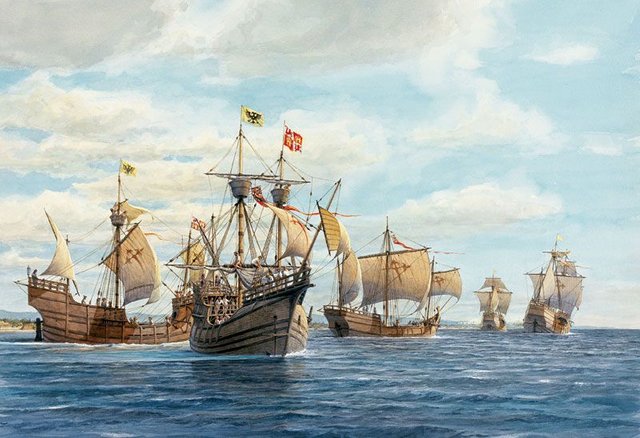
Off Guam, 6:OO A.M. , March 6, 1521. Lope Navarro, from his lookout perch 60 feet atop Magellan's ship Victoria, shouted "Tierra ! Tierra !", "Land !." His shrill cry tore through the silent morning and caused excitement among the sailors. It heralded the advent of the un-avoidable clash of civilizations that was to follow the meeting of the East and the West.
After 98 days at sea, Magellan's Armada de Molucca had traveled more than 7,000 miles without interruption, from the southern tip of South America, now called the Strait of Magellan, to the Western Pacific. It was the longest ocean voyage recorded until that time. Magellan.s men were tired, sick, and weary of the long voyage, and many were about to succumb to scurvy, starvation, and dehydration, their tongues swollen, breath foul, heads shaggy, and their eyes glassy. Land! Land ! The island, now known to us as Guam, must have been quite a welcome sight to the Europeans.
"Land !" Everyone was jubilant. Magellan climbed partway up to the lookout's perch to see the land himself. Overjoyed with the sight, he awarded Lope Navarro, the lookout, with a bonus of one hundred ducats on the spot. The West was about to meet the East, and the differences between their cultures were about to become violently manifest.
Four hours after sighting land, the Armada de Molucca eased into a deep turquoise lagoon (today’s Umatac Bay) of exceptionally warm and clear waters, and was soon surrounded by a welcoming party of outrigger canoes. The Europeans could see beaches, rocky cliffs, and steep thickly forested slopes. It was paradise, a verdant landscape of springs, streams, and waterfalls: everything a sailor too long at sea could want. The moment of contact between two societies, until now wholly ignorant of one another's existence, had finally arrived.
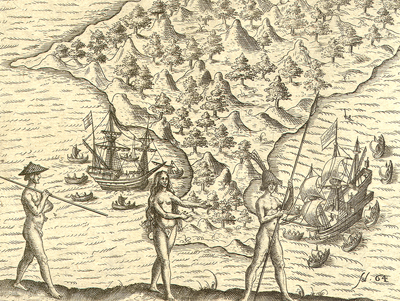
Innocent and undaunted, hundreds of Chamorros, as native Guamanians are to be called later, riding on their tiny proas, encircled Magellan's fleet. "Fearing nothing, they got aboard, and there were so many of them that some of our men asked the captain to have them thrown out," de Mafra recorded for posterity. The Chamorros boarded the flagship and stole everything they could - rigging, jars, weapons, and anything made of iron. Then it happened. "The boatswain of the flagship slapped one of those Indians for small reason, and the Indian slapped him back. Insulted, the boatswain stabbed him in the back with a machete he had carried on his waist," wrote de Mafra.
Thus was the first blood shed from the body of a native in his home turf , struck by the foreign invader who must have acted based on his concept of right or wrong, based solely on his culture's values, and ignorant and intolerant of the values of others.
The Chamorros "began fighting with their sticks, for they had nothing else...Some arrows were cast at them....being so many, the Indians managed to wound some of our men," added de Mafra.
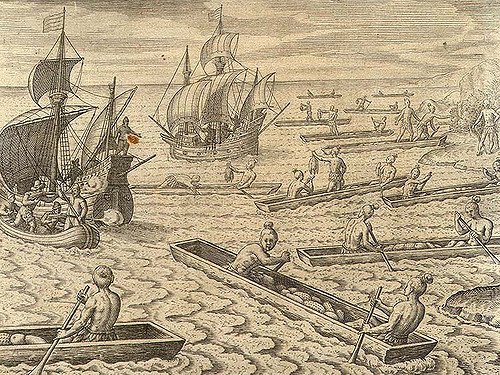
In the middle of the fracas, a second wave of Chamorros skimmed across the azure waters in their proas, and to the Europeans. utter astonishment, distributed food to Magellan.s starving sailors. Once they had fed the Europeans, the Chamorros picked up their sticks and began fighting again, this time more viciously. "Magellan, seeing that the number of people was increasing, ordered those in the ship to stop throwing arrows; with this the Indians stopped, the fighting subsided,, and they resumed selling food as before, the kind of food in those islands being coconut and fish aplenty, which were purchased in exchange for some glass beads."
Magellan's show of restraint turned out to be just the right gesture. Non-violence begot non-violence. Yet, as we shall see later, there is a darker side of Magellan, vengeful and violent.
The modest yet historic encounter between the Armada de Molucca and a few dozen outrigger canoes contained in microcosm the conflicting impulses of the European colonialist adventure - from initial innocence and curiosity, through confusion and fear, and bloodshed, all of it resolving in commercial activity.
If only matters had ended in this harmonious note. But it was not to be so. Unaccustomed to European concepts of trade and property, the Chamorros while happy to feed the sailors, failed to comprehend that some things aboard the ship were simply off limits.
Then the Chamorros made off with Magellan's personal small boat. The robbery could only be interpreted by the Europeans as an insult to the Captain General himself. The next day, Magellan was "much irritated," according to Pigafetta. He ordered 40 men in two longboats to go ashore. It was the first landing in history by Europeans on an inhabited Pacific island. They landed, not in peace, not to discover new land, but to harshly teach the natives lessons on European values, values completely unknown to the locals.
The Europeans promptly went into a rampage, "burned 40 or 50 houses and many boats, and killed seven men." The sailors who remained onboard the big ships called out to the landing party to bring back the internal organs of the slain Chamorros, which they will eat ostensibly to cure their scurvy. Their willingness to turn to cannibalism showed how desperate they had become, and revealed some flaws in their cultural values.
During the rampage, the Chamorros offered no resistance. The European crossbows were brutally effective. "When we wounded many of this kind of people with our arrows, which entered inside their bodies," Pigafetta wrote, "they looked at the arrows, and then drew it forth with much astonishment, and immediately afterwards died." Magellan recovered the stolen small boat.
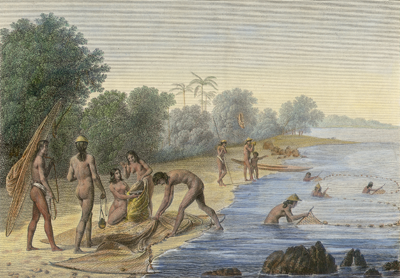
It is very sad that the historic first European landing in the Pacific was done in anger and violence that resulted in the deaths of unresisting natives, and the resort to cannibalism by the colonialists.
The Europeans were later surprised to find that the Chamorros possessed very few arms; their most dangerous weapon consisted of a stick with a fishbone attached to one end, and it was not used for combat but to catch fish. The Chamorros had naively "thought there were no other men in the world besides them," wrote Pigafetta. They had no concept of private property, they believed all possessions belonged to one and all. On this basis, they had been equally pleased to share their food and supplies with the intruders and they expected others to share their resources with them too.
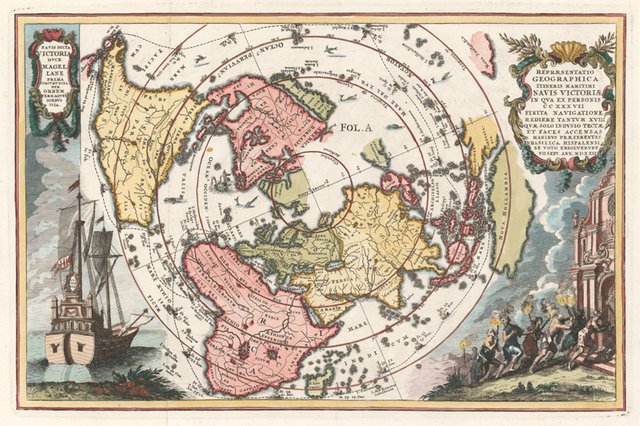
The Armada de Molucca lifted anchor and departed from Guam on March 9, 1521 with a fresh supply of food and water, leaving behind angry natives, one village burned, and at least seven Chamorros killed and many more wounded. Nevertheless, Magellan decided that the Chamorros' worst offense was their thievery, and christened the island and two others nearby as the Islas de los Ladrones - the Islands of the Thieves.
The burning of all the houses of an entire village by the Europeans upon orders of Magellan was to be repeated a month later in the Island of Mactan. This time, the natives fought back and killed him.
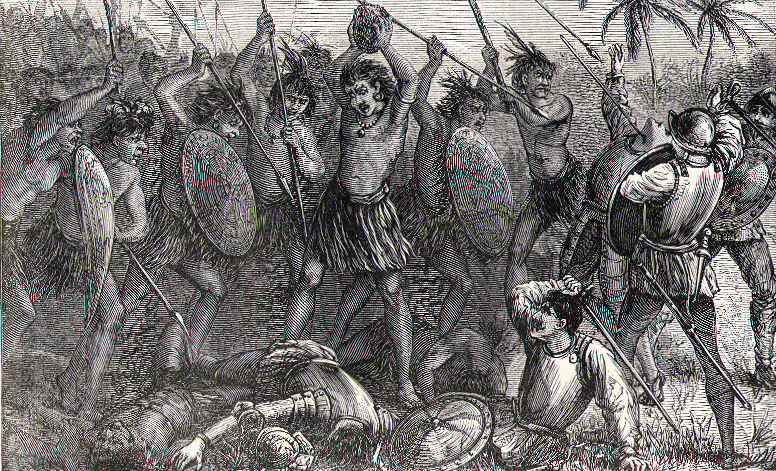
Reference(s)
Laurence Bergreen - Over the Edge of the World
Princeton University - Ferdinand Magellan
Guampedia - Ferdinand Magellan
Image Source(s): 1 2 3 4 5 6
You received a 10.0% upvote since you are not yet a member of geopolis and wrote in the category of "geopolis".
To read more about us and what we do, click here.
https://steemit.com/geopolis/@geopolis/geopolis-the-community-for-global-sciences-update-4
Congratulations, Your Post Has Been Added To The Steemit Worldmap!
Author link: http://steemitworldmap.com?author=pinas
Post link: http://steemitworldmap.com?post=east-meets-west-clash-of-civilizations
Want to have your post on the map too?
Hey there! You were featured on the #88th edition of steemitfamilyph's featured posts. Congratulations!